Indian Taxation System: An Argumentative Essay on GST Impact
VerifiedAdded on 2023/03/30
|5
|1028
|145
Essay
AI Summary
This essay provides an argumentative analysis of the Goods and Services Tax (GST) within the Indian taxation system, arguing that GST is beneficial for the nation due to increased tax collection and government spending, leading to national development. It explains GST as a multi-stage, comprehensive, and destination-based indirect tax that replaced numerous previous indirect taxes. The essay details the components of GST, including SGST, CGST, and IGST, and their application in intra-state and inter-state sales. While acknowledging concerns about the negative impact on the real estate market and increased costs in some sectors, the essay concludes that GST has simplified business operations, reduced prices, and positively impacted digitalization and macroeconomic growth, recommending its continued maintenance and improvement by the Indian government, with a focus on streamlining tax administration and stabilizing the GSTN portal. Desklib offers more solved assignments and resources for students.
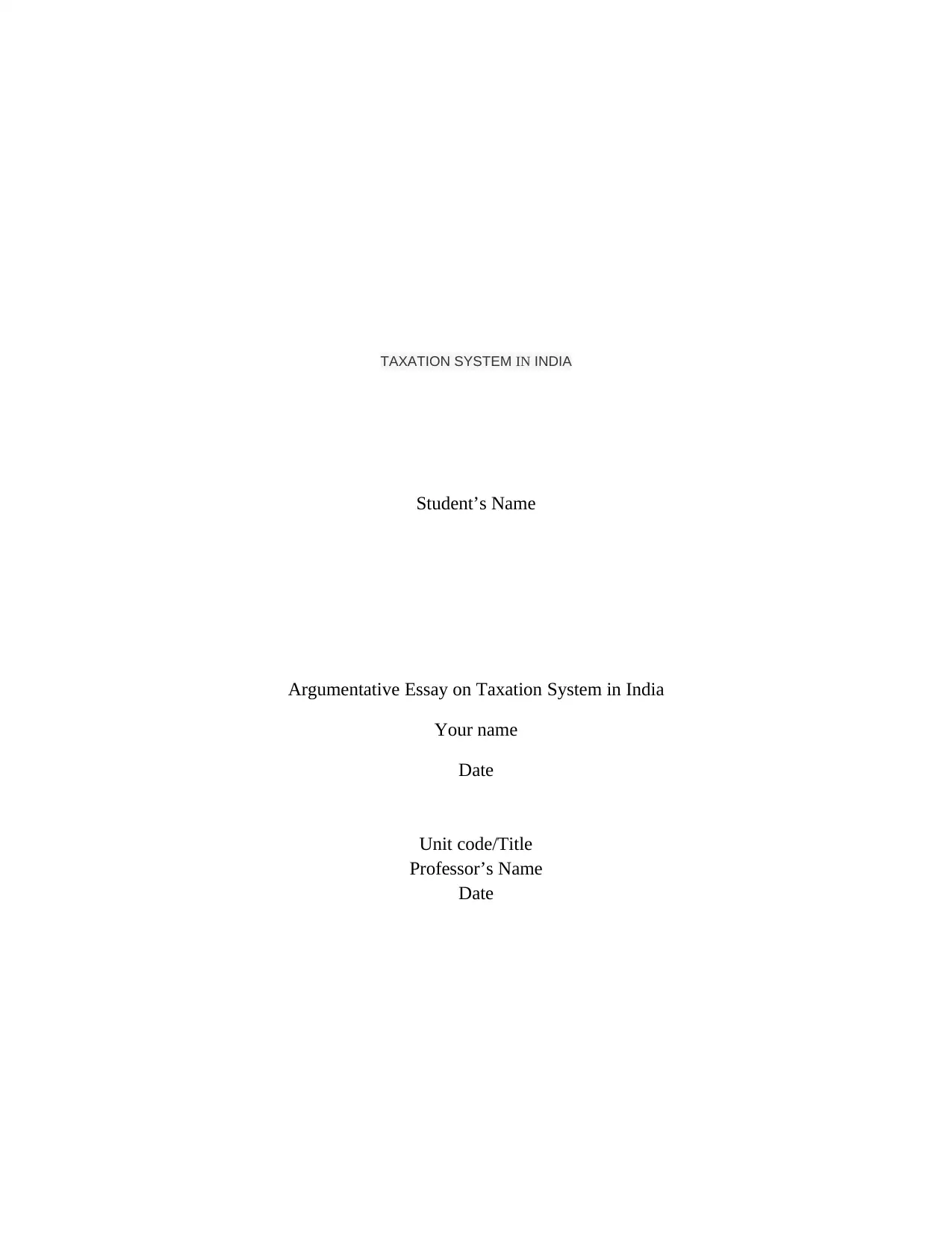
TAXATION SYSTEM IN INDIA
Student’s Name
Argumentative Essay on Taxation System in India
Your name
Date
Unit code/Title
Professor’s Name
Date
Student’s Name
Argumentative Essay on Taxation System in India
Your name
Date
Unit code/Title
Professor’s Name
Date
Paraphrase This Document
Need a fresh take? Get an instant paraphrase of this document with our AI Paraphraser
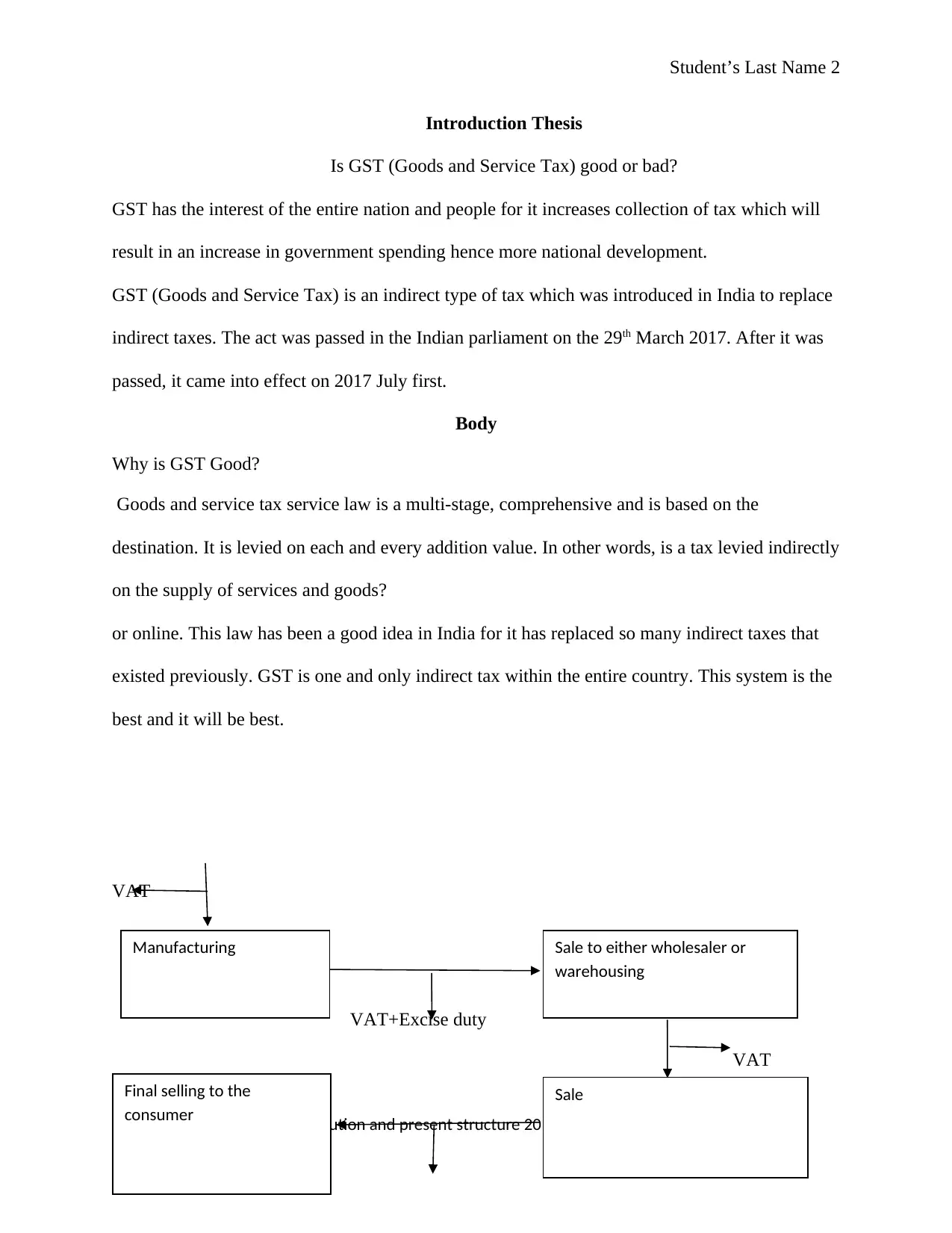
Student’s Last Name 2
Introduction Thesis
Is GST (Goods and Service Tax) good or bad?
GST has the interest of the entire nation and people for it increases collection of tax which will
result in an increase in government spending hence more national development.
GST (Goods and Service Tax) is an indirect type of tax which was introduced in India to replace
indirect taxes. The act was passed in the Indian parliament on the 29th March 2017. After it was
passed, it came into effect on 2017 July first.
Body
Why is GST Good?
Goods and service tax service law is a multi-stage, comprehensive and is based on the
destination. It is levied on each and every addition value. In other words, is a tax levied indirectly
on the supply of services and goods?
or online. This law has been a good idea in India for it has replaced so many indirect taxes that
existed previously. GST is one and only indirect tax within the entire country. This system is the
best and it will be best.
VAT
VAT+Excise duty
VAT
(Chelliah 2010)
(Viswanathan 2016)
(Sury, Tax system in India: evolution and present structure 2015)
(Gordon 2010)
Manufacturing
Final selling to the
consumer
Sale to either wholesaler or
warehousing
Sale
Introduction Thesis
Is GST (Goods and Service Tax) good or bad?
GST has the interest of the entire nation and people for it increases collection of tax which will
result in an increase in government spending hence more national development.
GST (Goods and Service Tax) is an indirect type of tax which was introduced in India to replace
indirect taxes. The act was passed in the Indian parliament on the 29th March 2017. After it was
passed, it came into effect on 2017 July first.
Body
Why is GST Good?
Goods and service tax service law is a multi-stage, comprehensive and is based on the
destination. It is levied on each and every addition value. In other words, is a tax levied indirectly
on the supply of services and goods?
or online. This law has been a good idea in India for it has replaced so many indirect taxes that
existed previously. GST is one and only indirect tax within the entire country. This system is the
best and it will be best.
VAT
VAT+Excise duty
VAT
(Chelliah 2010)
(Viswanathan 2016)
(Sury, Tax system in India: evolution and present structure 2015)
(Gordon 2010)
Manufacturing
Final selling to the
consumer
Sale to either wholesaler or
warehousing
Sale
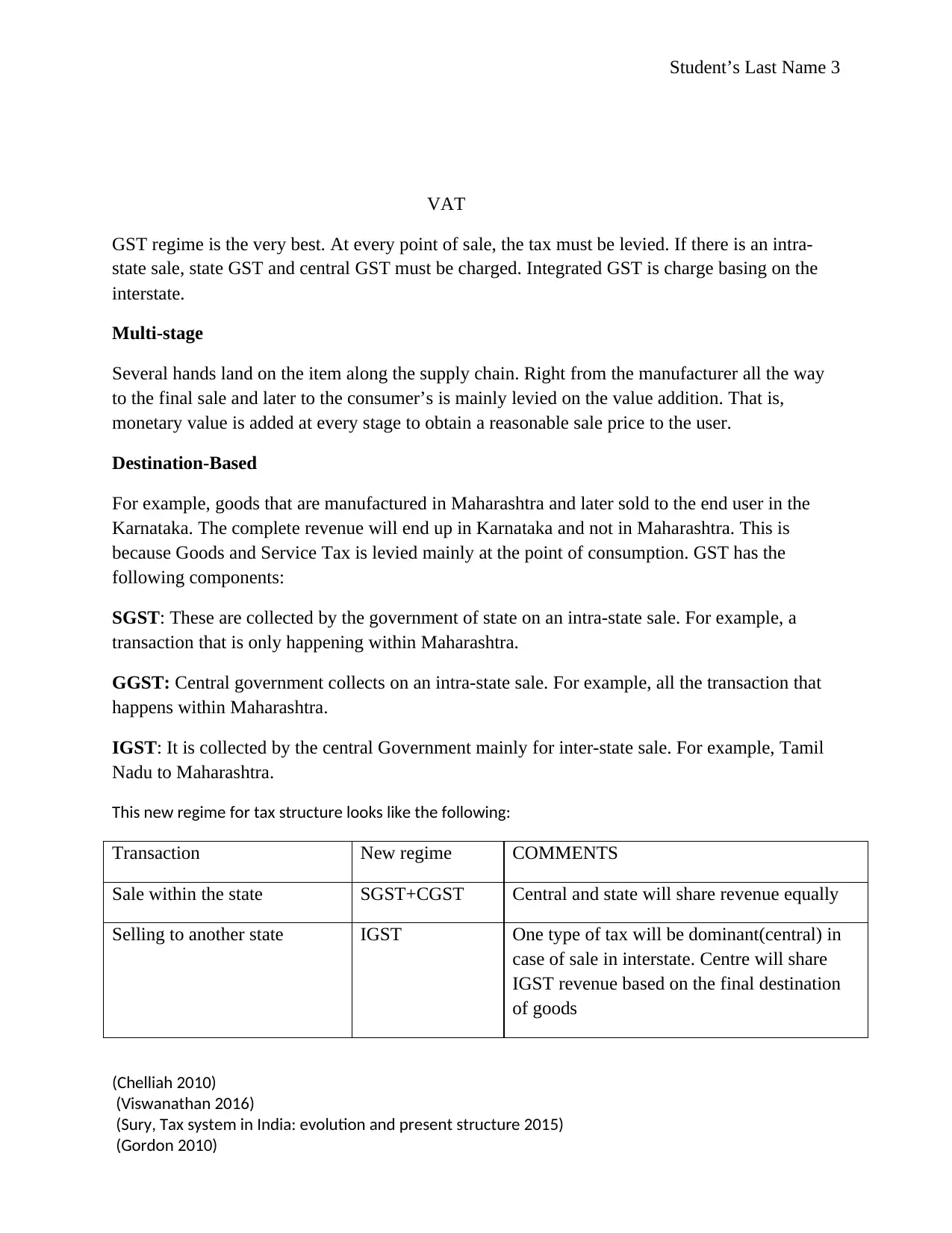
Student’s Last Name 3
VAT
GST regime is the very best. At every point of sale, the tax must be levied. If there is an intra-
state sale, state GST and central GST must be charged. Integrated GST is charge basing on the
interstate.
Multi-stage
Several hands land on the item along the supply chain. Right from the manufacturer all the way
to the final sale and later to the consumer’s is mainly levied on the value addition. That is,
monetary value is added at every stage to obtain a reasonable sale price to the user.
Destination-Based
For example, goods that are manufactured in Maharashtra and later sold to the end user in the
Karnataka. The complete revenue will end up in Karnataka and not in Maharashtra. This is
because Goods and Service Tax is levied mainly at the point of consumption. GST has the
following components:
SGST: These are collected by the government of state on an intra-state sale. For example, a
transaction that is only happening within Maharashtra.
GGST: Central government collects on an intra-state sale. For example, all the transaction that
happens within Maharashtra.
IGST: It is collected by the central Government mainly for inter-state sale. For example, Tamil
Nadu to Maharashtra.
This new regime for tax structure looks like the following:
Transaction New regime COMMENTS
Sale within the state SGST+CGST Central and state will share revenue equally
Selling to another state IGST One type of tax will be dominant(central) in
case of sale in interstate. Centre will share
IGST revenue based on the final destination
of goods
(Chelliah 2010)
(Viswanathan 2016)
(Sury, Tax system in India: evolution and present structure 2015)
(Gordon 2010)
VAT
GST regime is the very best. At every point of sale, the tax must be levied. If there is an intra-
state sale, state GST and central GST must be charged. Integrated GST is charge basing on the
interstate.
Multi-stage
Several hands land on the item along the supply chain. Right from the manufacturer all the way
to the final sale and later to the consumer’s is mainly levied on the value addition. That is,
monetary value is added at every stage to obtain a reasonable sale price to the user.
Destination-Based
For example, goods that are manufactured in Maharashtra and later sold to the end user in the
Karnataka. The complete revenue will end up in Karnataka and not in Maharashtra. This is
because Goods and Service Tax is levied mainly at the point of consumption. GST has the
following components:
SGST: These are collected by the government of state on an intra-state sale. For example, a
transaction that is only happening within Maharashtra.
GGST: Central government collects on an intra-state sale. For example, all the transaction that
happens within Maharashtra.
IGST: It is collected by the central Government mainly for inter-state sale. For example, Tamil
Nadu to Maharashtra.
This new regime for tax structure looks like the following:
Transaction New regime COMMENTS
Sale within the state SGST+CGST Central and state will share revenue equally
Selling to another state IGST One type of tax will be dominant(central) in
case of sale in interstate. Centre will share
IGST revenue based on the final destination
of goods
(Chelliah 2010)
(Viswanathan 2016)
(Sury, Tax system in India: evolution and present structure 2015)
(Gordon 2010)
⊘ This is a preview!⊘
Do you want full access?
Subscribe today to unlock all pages.

Trusted by 1+ million students worldwide
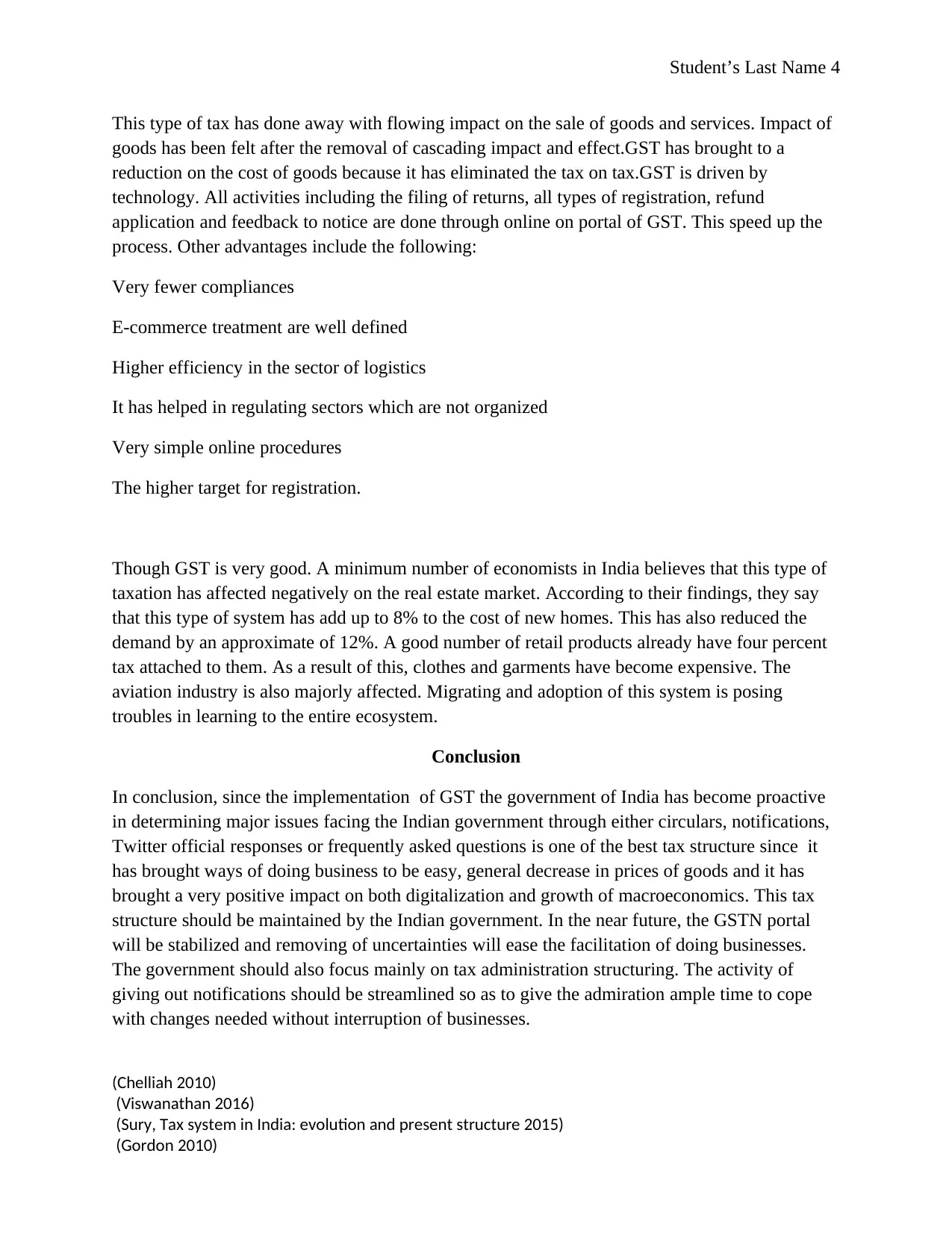
Student’s Last Name 4
This type of tax has done away with flowing impact on the sale of goods and services. Impact of
goods has been felt after the removal of cascading impact and effect.GST has brought to a
reduction on the cost of goods because it has eliminated the tax on tax.GST is driven by
technology. All activities including the filing of returns, all types of registration, refund
application and feedback to notice are done through online on portal of GST. This speed up the
process. Other advantages include the following:
Very fewer compliances
E-commerce treatment are well defined
Higher efficiency in the sector of logistics
It has helped in regulating sectors which are not organized
Very simple online procedures
The higher target for registration.
Though GST is very good. A minimum number of economists in India believes that this type of
taxation has affected negatively on the real estate market. According to their findings, they say
that this type of system has add up to 8% to the cost of new homes. This has also reduced the
demand by an approximate of 12%. A good number of retail products already have four percent
tax attached to them. As a result of this, clothes and garments have become expensive. The
aviation industry is also majorly affected. Migrating and adoption of this system is posing
troubles in learning to the entire ecosystem.
Conclusion
In conclusion, since the implementation of GST the government of India has become proactive
in determining major issues facing the Indian government through either circulars, notifications,
Twitter official responses or frequently asked questions is one of the best tax structure since it
has brought ways of doing business to be easy, general decrease in prices of goods and it has
brought a very positive impact on both digitalization and growth of macroeconomics. This tax
structure should be maintained by the Indian government. In the near future, the GSTN portal
will be stabilized and removing of uncertainties will ease the facilitation of doing businesses.
The government should also focus mainly on tax administration structuring. The activity of
giving out notifications should be streamlined so as to give the admiration ample time to cope
with changes needed without interruption of businesses.
(Chelliah 2010)
(Viswanathan 2016)
(Sury, Tax system in India: evolution and present structure 2015)
(Gordon 2010)
This type of tax has done away with flowing impact on the sale of goods and services. Impact of
goods has been felt after the removal of cascading impact and effect.GST has brought to a
reduction on the cost of goods because it has eliminated the tax on tax.GST is driven by
technology. All activities including the filing of returns, all types of registration, refund
application and feedback to notice are done through online on portal of GST. This speed up the
process. Other advantages include the following:
Very fewer compliances
E-commerce treatment are well defined
Higher efficiency in the sector of logistics
It has helped in regulating sectors which are not organized
Very simple online procedures
The higher target for registration.
Though GST is very good. A minimum number of economists in India believes that this type of
taxation has affected negatively on the real estate market. According to their findings, they say
that this type of system has add up to 8% to the cost of new homes. This has also reduced the
demand by an approximate of 12%. A good number of retail products already have four percent
tax attached to them. As a result of this, clothes and garments have become expensive. The
aviation industry is also majorly affected. Migrating and adoption of this system is posing
troubles in learning to the entire ecosystem.
Conclusion
In conclusion, since the implementation of GST the government of India has become proactive
in determining major issues facing the Indian government through either circulars, notifications,
Twitter official responses or frequently asked questions is one of the best tax structure since it
has brought ways of doing business to be easy, general decrease in prices of goods and it has
brought a very positive impact on both digitalization and growth of macroeconomics. This tax
structure should be maintained by the Indian government. In the near future, the GSTN portal
will be stabilized and removing of uncertainties will ease the facilitation of doing businesses.
The government should also focus mainly on tax administration structuring. The activity of
giving out notifications should be streamlined so as to give the admiration ample time to cope
with changes needed without interruption of businesses.
(Chelliah 2010)
(Viswanathan 2016)
(Sury, Tax system in India: evolution and present structure 2015)
(Gordon 2010)
Paraphrase This Document
Need a fresh take? Get an instant paraphrase of this document with our AI Paraphraser
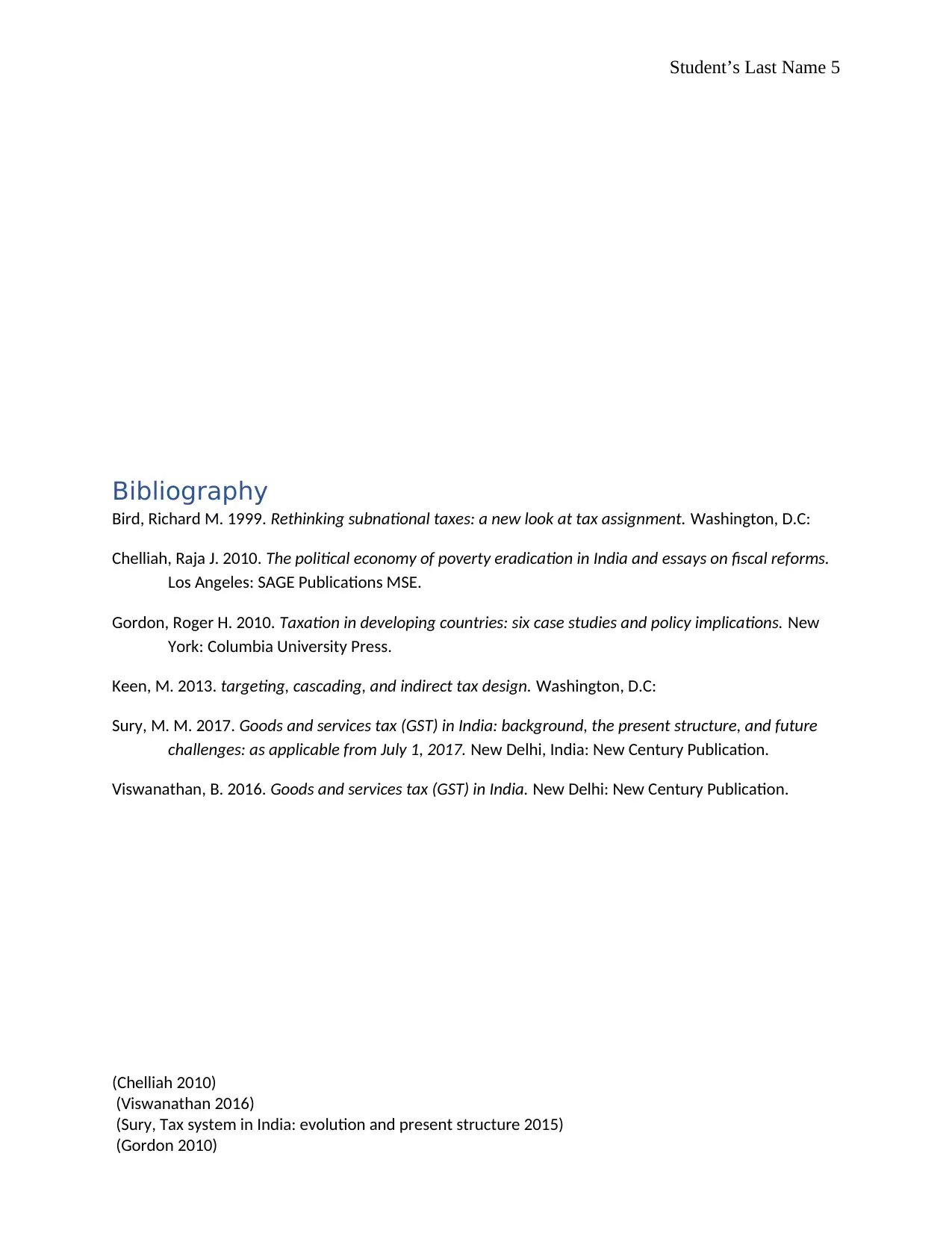
Student’s Last Name 5
Bibliography
Bird, Richard M. 1999. Rethinking subnational taxes: a new look at tax assignment. Washington, D.C:
Chelliah, Raja J. 2010. The political economy of poverty eradication in India and essays on fiscal reforms.
Los Angeles: SAGE Publications MSE.
Gordon, Roger H. 2010. Taxation in developing countries: six case studies and policy implications. New
York: Columbia University Press.
Keen, M. 2013. targeting, cascading, and indirect tax design. Washington, D.C:
Sury, M. M. 2017. Goods and services tax (GST) in India: background, the present structure, and future
challenges: as applicable from July 1, 2017. New Delhi, India: New Century Publication.
Viswanathan, B. 2016. Goods and services tax (GST) in India. New Delhi: New Century Publication.
(Chelliah 2010)
(Viswanathan 2016)
(Sury, Tax system in India: evolution and present structure 2015)
(Gordon 2010)
Bibliography
Bird, Richard M. 1999. Rethinking subnational taxes: a new look at tax assignment. Washington, D.C:
Chelliah, Raja J. 2010. The political economy of poverty eradication in India and essays on fiscal reforms.
Los Angeles: SAGE Publications MSE.
Gordon, Roger H. 2010. Taxation in developing countries: six case studies and policy implications. New
York: Columbia University Press.
Keen, M. 2013. targeting, cascading, and indirect tax design. Washington, D.C:
Sury, M. M. 2017. Goods and services tax (GST) in India: background, the present structure, and future
challenges: as applicable from July 1, 2017. New Delhi, India: New Century Publication.
Viswanathan, B. 2016. Goods and services tax (GST) in India. New Delhi: New Century Publication.
(Chelliah 2010)
(Viswanathan 2016)
(Sury, Tax system in India: evolution and present structure 2015)
(Gordon 2010)
1 out of 5
Related Documents
Your All-in-One AI-Powered Toolkit for Academic Success.
+13062052269
info@desklib.com
Available 24*7 on WhatsApp / Email
![[object Object]](/_next/static/media/star-bottom.7253800d.svg)
Unlock your academic potential
Copyright © 2020–2025 A2Z Services. All Rights Reserved. Developed and managed by ZUCOL.


